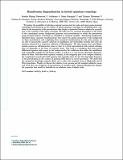Por favor, use este identificador para citar o enlazar a este item:
http://hdl.handle.net/10261/208560COMPARTIR / EXPORTAR:
 SHARE SHARE
 CORE
BASE CORE
BASE
|
|
| Visualizar otros formatos: MARC | Dublin Core | RDF | ORE | MODS | METS | DIDL | DATACITE | |

| Título: | Hamiltonian diagonalization in hybrid quantum cosmology |
Autor: | Elizaga Navascués, Beatriz CSIC ORCID; Mena Marugán, Guillermo A. CSIC ORCID; Thiemann, T. | Fecha de publicación: | 23-ago-2019 | Editor: | IOP Publishing | Citación: | Classical and Quantum Gravity 36:18 (2019) | Resumen: | We explore the possibility of selecting a natural vacuum state for scalar and tensor gauge-invariant cosmological perturbations in the context of hybrid quantum cosmology, by identifying those variables for the description of the perturbations that display a dynamical behavior adapted in a specific way to the evolution of the entire cosmology. We make use of a canonical formulation of the whole of the cosmological system (background geometry and perturbations) in which the perturbative gauge-invariant degrees of freedom are identified as canonical variables. Introducing background-dependent linear canonical transformations that respect the spatial symmetries of the background on these perturbations and completing those canonical transformations for the entire system, we are able to characterize a generic collection of annihilation and creationlike variables that obey the dynamics dictated by a respective collection of Hamiltonians. We then impose that such Hamiltonians possess no self-interaction terms so that, in a Fock representation with normal ordering, they act diagonally on the basis of n-particle states. This leads to a semilinear first-order partial differential equation with respect to the background for the coefficients that define the annihilation and creationlike variables for all Fourier modes, as well as to a very precise ultraviolet characterization of them. Such first-order equation contains, in the imaginary part of its complex solutions, the complicated second-order field equation that typically arises for the time-dependent frequency of the perturbations in the context of quantum field theory in curved spacetimes. We check that the asymptotic knowledge acquired allows one to select the standard vacua in Minkowski and de Sitter spacetimes. Finally, we discuss the relation of our vacuum and the standard adiabatic vacua, and check that our asymptotic characterization of variables with a diagonal Hamiltonian displays the properties that would be desirable for an adiabatic state of infinite order. | Descripción: | 22 pags. | Versión del editor: | http://dx.doi.org/10.1088/1361-6382/ab32af | URI: | http://hdl.handle.net/10261/208560 | DOI: | 10.1088/1361-6382/ab32af | Identificadores: | doi: 10.1088/1361-6382/ab32af issn: 1361-6382 |
| Aparece en las colecciones: | (CFMAC-IEM) Artículos |
Ficheros en este ítem:
| Fichero | Descripción | Tamaño | Formato | |
|---|---|---|---|---|
| Hamiltonian diagonalization.pdf | 349,68 kB | Adobe PDF |  Visualizar/Abrir |
CORE Recommender
SCOPUSTM
Citations
21
checked on 31-mar-2024
WEB OF SCIENCETM
Citations
20
checked on 26-feb-2024
Page view(s)
99
checked on 22-abr-2024
Download(s)
96
checked on 22-abr-2024
Google ScholarTM
Check
Altmetric
Altmetric
NOTA: Los ítems de Digital.CSIC están protegidos por copyright, con todos los derechos reservados, a menos que se indique lo contrario.
